
Rabbit Anti-PTPN1 antibody
PTP-1B; Non receptor tyrosine phosphatase 1; Protein tyrosine phosphatase 1B; Protein-tyrosine phosphatase 1B; Protein tyrosine phosphatase non receptor type 1; Protein tyrosine phosphatase placental; PTP 1B; PTPN 1; PTPN1; Tyrosine protein phosphatase no
View History [Clear]
Details
Product Name [KO validated anti] PTPN1 Chinese Name 蛋白酪氨酸磷酸酶-1B抗体 Alias PTP-1B; Non receptor tyrosine phosphatase 1; Protein tyrosine phosphatase 1B; Protein-tyrosine phosphatase 1B; Protein tyrosine phosphatase non receptor type 1; Protein tyrosine phosphatase placental; PTP 1B; PTPN 1; PTPN1; Tyrosine protein phosphatase non receptor type 1; PTP-HA2; Protein-tyrosine phosphatase HA2; PTN1_HUMAN. Research Area Cell biology Neurobiology Signal transduction Kinases and Phosphatases Immunogen Species Rabbit Clonality Polyclonal React Species Human, Mouse, Rat, Applications WB=1:500-2000 IHC-P=1:50-200 ICC=1:100 (Paraffin sections need antigen repair)
not yet tested in other applications.
optimal dilutions/concentrations should be determined by the end user.Theoretical molecular weight 48kDa Cellular localization cytoplasmic The cell membrane Form Liquid Concentration 1mg/ml immunogen Recombinant human PTPN1: 281-435/435 Lsotype IgG Purification affinity purified by Protein A Buffer Solution 0.01M TBS(pH7.4) with 1% BSA, 0.03% Proclin300 and 50% Glycerol. Storage Store at -20 °C for one year. Avoid repeated freeze/thaw cycles. The lyophilized antibody is stable at room temperature for at least one month and for greater than a year when kept at -20°C. When reconstituted in sterile pH 7.4 0.01M PBS or diluent of antibody the antibody is stable for at least two weeks at 2-4 °C. Attention This product as supplied is intended for research use only, not for use in human, therapeutic or diagnostic applications. PubMed PubMed Product Detail PTP1B is the prototypic member of the protein tyrosine phosphatase (PTP) family, which comprises at least 37 proteins. The family is characterized by a catalytic phosphatase domain of approximately 240 amino acids, and includes both transmembrane and cytosolic enzymes. The PTPs have high substrate specificity for phosphotyrosyl proteins. At the primary sequence level, PTPs share little similarity with the protein serine phosphatases, protein threonine phosphatases, or the acid and alkaline phosphatases. PTP1B is a negative regulator of insulin and leptin signal transduction and is a drug discovery target in the fields of diabetes and obesity. Insulin also influences the expression of splice variants of PTP1B.
PTP1B also interacts with Insulin and EGF receptors, and undergoes phosphorylation after receptor stimulation. Tyrosine phosphorylation at Tyr-66, Tyr-152, and Tyr-153 occurs after insulin receptor activation, and tyrosine phosphorylation of Tyr-152 may be required for interactions with N-Cadherin. In addition, Akt can phosphorylate Ser-50 and this phosphorylation can reduce PTP1B activity.
Function:
Tyrosine-protein phosphatase which acts as a regulator of endoplasmic reticulum unfolded protein response. Mediates dephosphorylation of EIF2AK3/PERK; inactivating the protein kinase activity of EIF2AK3/PERK. May play an important role in CKII- and p60c-src-induced signal transduction cascades. May regulate the EFNA5-EPHA3 signaling pathway which modulates cell reorganization and cell-cell repulsion
Subunit:
Interacts with EPHA3 (phosphorylated); dephosphorylates EPHA3 and may regulate its trafficking and function.
Subcellular Location:
Endoplasmic reticulum membrane; Peripheral membrane protein; Cytoplasmic side. Note=Interacts with EPHA3 at the cell membrane.
Tissue Specificity:
Most abundant in testis. Also found in kidney, spleen, muscle, liver, heart and brain.
Post-translational modifications:
Ser-50 is the major site of phosphorylation as compared to Ser-242 and Ser-243. Activated by phosphorylation at Ser-50.
S-nitrosylation of Cys-215 inactivates the enzyme activity.
Sulfhydration at Cys-215 following endoplasmic reticulum stress inactivates the enzyme activity, promoting EIF2AK3/PERK activity.
SWISS:
P18031
Gene ID:
5770
Database links:Entrez Gene: 5770 Human
Entrez Gene: 19246 Mouse
Omim: 176885 Human
SwissProt: P18031 Human
SwissProt: P35821 Mouse
Unigene: 417549 Human
Unigene: 277916 Mouse
Unigene: 11317 Rat
蛋白酪氨酸磷酸酶1B(PTP1B)是一种胰岛素信号的负性调节因子,与肥胖症和2型Diabetes的发病及发展关系密切。对P-tyr基因敲除小鼠的研究表明,缺失PTP1B小鼠的胰岛素敏感性明显增加,并对肥胖有一定的抵抗作用,而另一些对动物和人体的研究结果却与此相反,发现PTP1B可通过引起胰岛素抵抗、瘦素抵抗及影响脂代谢等而导致肥胖症和2型Diabetes的发生。一些特异性的Ptyr小分子抑制剂已经开发并用于肥胖和Diabetes的治疗中。Product Picture
Lane 1: Hela (Human) Cell Lysate at 25 ug
Lane 2: PTPN1 knockout (KO) Hela (Human) Cell Lysate at 25 ug
Primary: Anti-PTPN1 (SL55182R) at 1/1000 dilution
Secondary: HRP Goat Anti-Rabbit IgG (H+L) at 1:10000 dilution
Predicted band size: 50 kD
Observed band size: 50 kD
Sample:
Lane 1: Hela (Human) Cell Lysate at 30 ug
Lane 2: K562 (Human) Cell Lysate at 30 ug
Lane 3: Huvec (Human) Cell Lysate at 30 ug
Lane 4: U87MG (Human) Cell Lysate at 30 ug
Primary: Anti- PTPN1 (SL55182R) at 1/1000 dilution
Secondary: IRDye800CW Goat Anti-Rabbit IgG at 1/20000 dilution
Predicted band size: 50 kD
Observed band size: 47 kD
Paraformaldehyde-fixed, paraffin embedded (mouse brain); Antigen retrieval by boiling in sodium citrate buffer (pH6.0) for 15min; Block endogenous peroxidase by 3% hydrogen peroxide for 20 minutes; Blocking buffer (normal goat serum) at 37°C for 30min; Antibody incubation with (PTPN1) Polyclonal Antibody, Unconjugated (SL55182R) at 1:100 overnight at 4°C, followed by operating according to SP Kit(Rabbit) (sp-0023) instructionsand DAB staining.Paraformaldehyde-fixed, paraffin embedded (rat brain); Antigen retrieval by boiling in sodium citrate buffer (pH6.0) for 15min; Block endogenous peroxidase by 3% hydrogen peroxide for 20 minutes; Blocking buffer (normal goat serum) at 37°C for 30min; Antibody incubation with (PTPN1) Polyclonal Antibody, Unconjugated (SL55182R) at 1:100 overnight at 4°C, followed by operating according to SP Kit(Rabbit) (sp-0023) instructionsand DAB staining.MCF7 cell; 4% Paraformaldehyde-fixed; Triton X-100 at room temperature for 20 min; Blocking buffer (normal goat serum, C-0005) at 37°C for 20 min; Antibody incubation with (KO Validated)PTPN1 polyclonal Antibody, Unconjugated (SL55182R) 1:100, 90 minutes at 37°C; followed by a conjugated Goat Anti-Rabbit IgG antibody at 37°C for 90 minutes, DAPI (blue, C02-04002) was used to stain the cell nuclei.
References (0)
No References
Bought notes(bought amounts latest0)
No one bought this product
User Comment(Total0User Comment Num)
- No comment
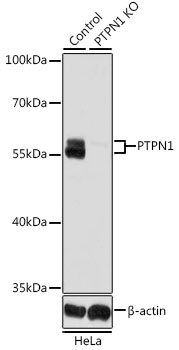
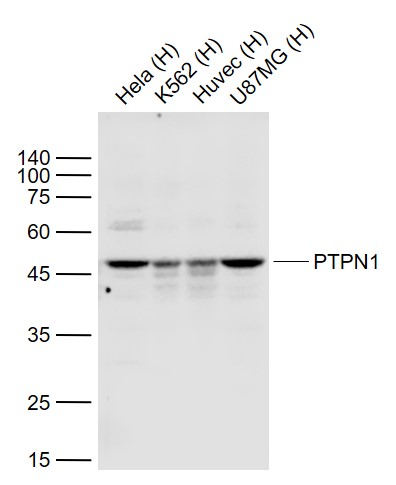
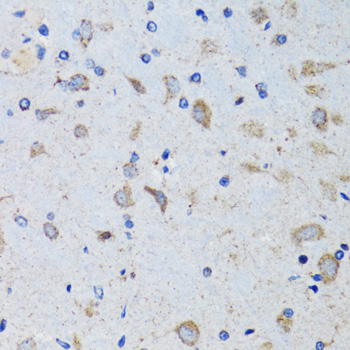
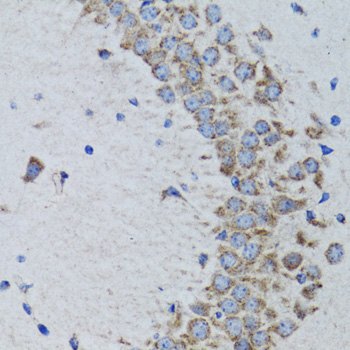
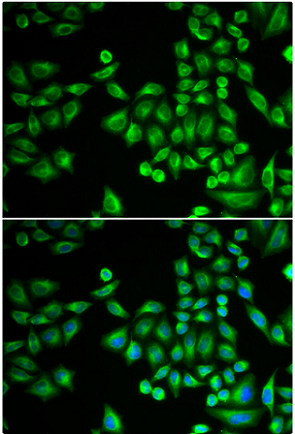


 +86 571 56623320
+86 571 56623320
 +86 18668110335
+86 18668110335

